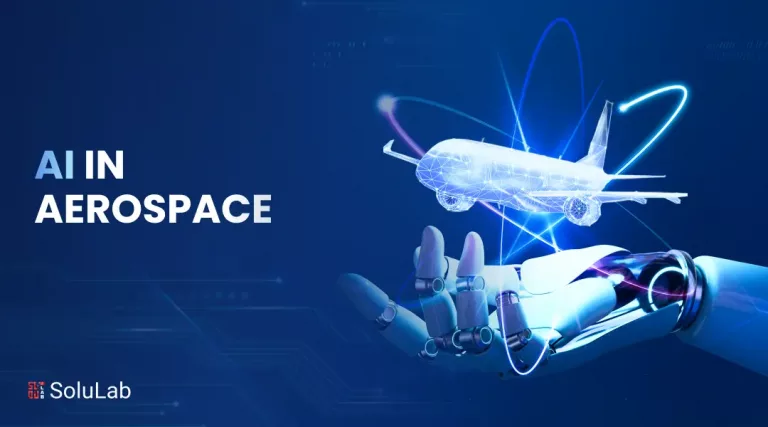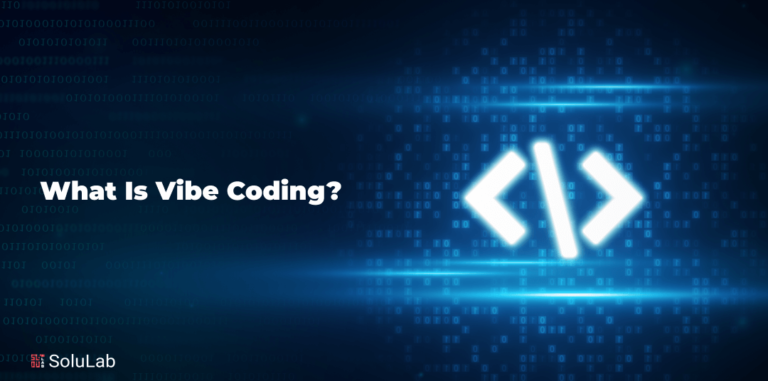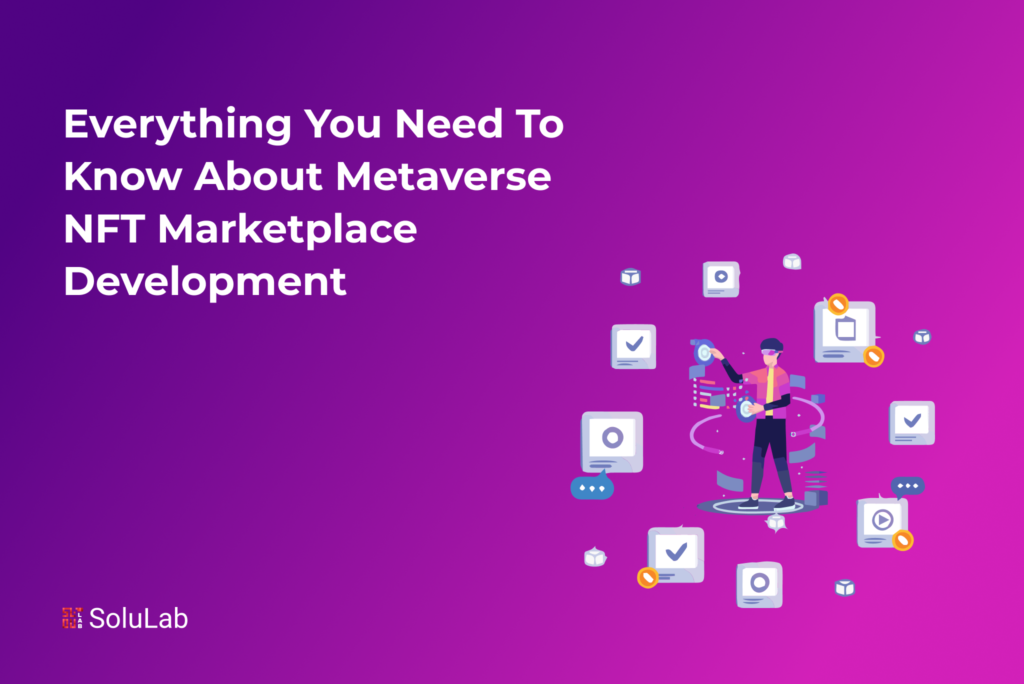
The notion of the metaverse NFT has gained great popularity in recent years, capturing the imaginations of both consumers and companies. Non-Fungible Tokens (NFTs) have emerged as an essential component of the metaverse as it continues to expand. The NFT marketplace, which acts as a venue for trading, buying, and selling these unique digital assets, is a critical component of the metaverse.
The metaverse’s development has transformed the digital world, providing immersive virtual experiences and a new frontier for interaction. Non-fungible tokens (NFTs), digital assets that grant ownership and authenticity to distinct virtual goods, are at the heart of this breakthrough technology. Metaverse NFT Metaverse Marketplace has become a haven for producers, collectors, and fans to exchange and display virtual goods. This blog will cover all you need about Metaverse NFT Marketplace creation, from important principles to the process.
The metaverse is a virtual world in which people may interact with one another and their surroundings in a highly immersive and linked way. It is a communal virtual shared area that blurs the distinction between the physical and digital worlds. Consider it a massive digital world comprising linked virtual environments such as video games, social networks, virtual reality experiences, and more. This blog article will review everything you need to know regarding establishing a Metaverse NFT Marketplace.
What Exactly are NFTs?
Non-fungible Tokens (NFTs) are one-of-a-kind digital assets kept on a blockchain, often Ethereum’s blockchain, through the ERC-721 or ERC-1155 specifications. NFTs, unlike cryptocurrencies such as Bitcoin or Ethereum, cannot be swapped one-to-one due to their distinct properties. Each NFT Metaverse has individual indivisible features, making replication or interchange impossible. Because of these characteristics, NFTs are suitable for expressing ownership of digital assets like artwork, collectibles, virtual real estate, virtual products, and more.
What is the Metaverse’s Role in NFT Marketplaces Development?
NFT markets are online marketplaces where anyone may purchase, sell, and exchange Metaverse NFT. They serve as go-betweens, connecting makers and collectors from all over the world.
These platforms ensure digital asset validity, provenance, and ownership by providing a safe and user-friendly environment for NFT transactions.
What are the Key Concepts in Metaverse NFT Marketplaces Development?
Non-fungible tokens (NFTs) are one-of-a-kind digital assets representing ownership of virtual goods such as artwork, collectibles, virtual real estate, and more. Each NFT is unique and indivisible, giving evidence of ownership and validity on the blockchain.
These platforms allow users to buy, sell, and trade NFTs. They provide creators with a smooth and safe place to promote and sell their digital works, while collectors can find and purchase unique virtual items.
Smart contracts are self-executing agreements allowing parties to conduct transactions without using intermediaries. They are critical components of Metaverse NFTs Marketplace. They are providing safe ownership transfer and automating royalty payments to authors.
How to Create a Metaverse NFT Marketplace?
Creating a Metaverse NFT Marketplace development entails many critical phases. Here are some important considerations:
-
Conceptualisation and Planning
Identify your NFT Metavercce marketplace’s objective, target audience, and unique selling characteristics. Investigate current platforms to discover gaps and possibilities that may be capitalized on.
-
Platform Selection
Choose an appropriate blockchain platform that supports NFTs. Ethereum is now the most popular option, but other blockchains, such as Binance Smart Chain and Flow, are gaining steam. When selecting a blockchain platform, consider scalability, transaction costs, and community support.
-
Smart Contract Development
Create smart contracts using Solidity or another programming language relevant to your blockchain platform of choice. The rules and functionality of NFTs, such as ownership, transferability, and royalties, are defined via smart contracts.
-
User Interface and Experience
Create an easy-to-use interface for your NFT marketplace. To appeal to desktop and mobile consumers, consider elements like ease of navigation, smooth onboarding, and responsive design.
Read Our Blog: What Are NFT dApps and How To Launch A Full-Stack NFT Marketplace dApp?
-
Security and Scalability
Security is a top priority in the Metaverse NFT marketplace to safeguard user data, digital assets, and transactions. Implement strong security mechanisms to safeguard user data, prevent fraud, and assure transaction integrity. Using open-source database managers helps developers ensure secure, transparent, and customizable data handling.
-
Wallet Integration
Integrate popular cryptocurrency wallets such as MetaMask or Trust Wallet to promote smooth transactions and give users a convenient experience.
-
Community and Social Features
Include social features like user profiles, comments, and sharing options to encourage interaction and community-building inside your NFT marketplace.
-
Marketing and Promotion
Develop a complete marketing approach to attract artists, collectors, and fans to your platform. Social media, influencers, and partnerships increase awareness and user uptake.
How Does NFT Marketplace Work on the Metaverse?
The NFT and metaverse have arisen as a virtual cosmos in which people may connect and exchange. Integrating Non-Fungible Token (NFT) markets is one of the fundamental aspects driving this digital ecosystem. This article examines how NFT markets work in the metaverse, including the underlying technology, buying and selling NFTs, and the impact on producers and users.
Before entering into an NFT Marketplace development, it’s critical to understand the principles of NFTs and blockchain technology. NFTs are one-of-a-kind digital assets on a blockchain, typically developed on platforms such as Ethereum. Each NFT has unique properties and cannot be traded one for one.
The Metaverse’s NFT Marketplaces: How Do They Work?
- Creation & Minting
To begin the metaverse journey of an NFT, creators mint their digital assets as NFTs. This procedure entails using specific platforms or markets that allow producers to post digital files such as artwork, virtual fashion, music, or collectibles. During the minting process, metadata identifying the NFT’s unique qualities, ownership information, and any further details the author desires to provide are added to the NFT.
- Listing and Discoverability
Once an NFT is minted, it may be listed for sale on the metaverse’s NFT marketplaces. These marketplaces serve as virtual shops for potential purchasers to view NFTs. They are detailing the NFT, its price, and the creator’s terms of sale. Users may search the marketplace for and browse through a variety of NFTs.
- Buying and Selling
When a buyer discovers an NFT they like, they may purchase it. NFT markets support transactions through cryptocurrency, most often Ether (ETH). The buyer submits a bid or buys the NFT at the quoted price. When the transaction is completed successfully, ownership of the NFT is transferred to the buyer’s digital wallet, and the transaction details are recorded on the blockchain.
Read Also: Solana NFT Marketplace: How to build your own NFT Marketplace on Solana
- Secondary Market Trade
Besides main sales, Metaverse NFT Marketplace markets enable secondary market trade. An individual who has an NFT has the opportunity to sell or exchange it with others. These secondary market transactions occur on the marketplace platform, with the marketplace serving as a middleman to ensure secure and transparent trades.
- Royalties and Smart Contracts
NFT and Metaverse price creators can include smart contracts in their digital assets. Smart contracts are agreements that self-execute and automate certain activities depending on predetermined parameters. Creators may establish royalty rates using smart contracts, allowing them to earn a percentage of future sales if their NFT is purchased in the secondary market. When a resale happens, these royalties are immediately sent to the inventor’s wallet, guaranteeing that the original creator continues to benefit.
- Interoperability and Cross-Platform Integration
Metaverse NFT price Marketplace markets encourage interoperability by allowing users to transfer and use their digital assets across multiple virtual worlds and platforms. This implies that an NFT bought in one metaverse may be used or shown in another, broadening the scope and utility of these virtual assets.
What are the Different Types of Metaverse NFT Marketplace?
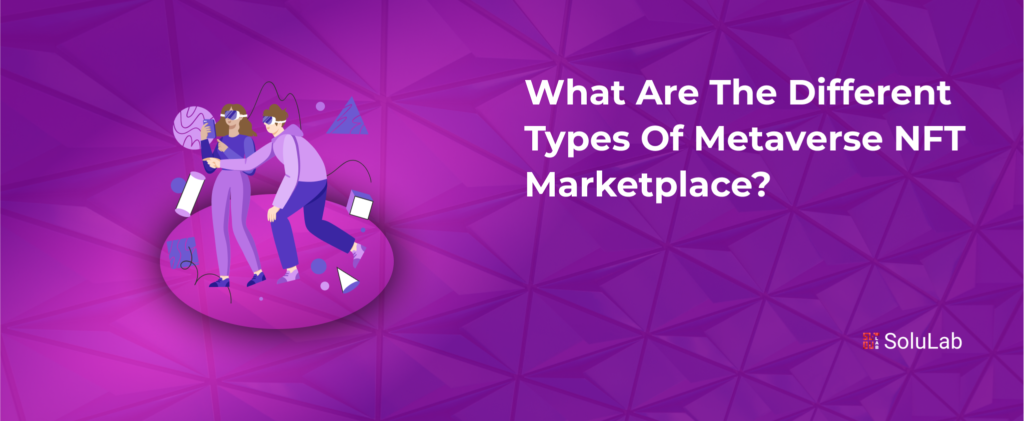
The metaverse is constantly growing, with a wide spectrum of metaverse NFT price catering to various hobbies and user preferences. These markets act as portals to the virtual world, letting users purchase, sell, and trade unique digital assets known as Non-Fungible Tokens (NFTs). This article will look at many Metaverse NFT Marketplace development, each with its features, purpose, and target audience.
1. General NFT markets
General NFT markets are the core of the metaverse ecosystem, offering a diverse range of digital goods in various categories. These markets are the go-to sites for consumers who want to discover and interact with a diverse spectrum of NFTs, such as digital art, collectables, virtual fashion, gaming equipment, and more. OpenSea is an example of a generic NFT marketplace.
2. Virtual Real Estate Marketplaces
These sites specialize in the purchase and sale of virtual land and properties within the NFTs and metaverse. These markets allow users to purchase virtual land plots for various uses, such as erecting virtual constructions, organizing events, or starting virtual enterprises. Virtual real estate marketplaces in the metaverse include Decentraland and Sandbox.
3. Gaming NFT markets
Gaming NFT markets cater to the gaming community, particularly providing a venue for trading in-game products, characters, and accessories as NFTs. These markets let users monetize their gaming experiences by selling unique or valuable virtual items to other players. Gaming NFT markets include Axie Infinity, NBA Top Shot, and Gods Unchained.
4. Art and Collectibles Marketplaces
Metaverse art and collectibles marketplaces focus on displaying and exchanging digital art, rare collectibles, and limited edition items. These platforms connect artists and collectors by allowing artists to exhibit and sell their digital creations and collectors to buy and display unique digital artworks. SuperRare and KnownOrigin are well-known metaverse art and collectibles marketplaces.
Read Also: Metaverse NFT – Foundation Of Next Blockchain Revolution!
5. Social NFT markets
In the metaverse, social NFT in the Metaverse prices prioritizes community involvement and social interaction. Virtual galleries, social profiles, discussion rooms, and the opportunity to follow and connect with other users are all available on these platforms.
They provide creators and enthusiasts a place to network, share ideas, and cooperate. Social NFT markets that generate a feeling of community in the metaverse include Async Art and Mintbase.
6. Clothing and Avatar Marketplaces
Fashion and avatar marketplaces in NFT in the Metaverse focus on virtual apparel, accessories, and customizable avatars. Users may purchase and modify their virtual identities on these markets, allowing them to show their style and uniqueness.
Users may improve their virtual presence by purchasing virtual apparel, accessories, haircuts, and other configurable aspects. Decentraland’s Fashion District and Cryptovoxels are two examples.
7. Niche and Specialized Marketplaces
Aside from the major categories described above, the metaverse offers smaller, specialized marketplaces catering to certain hobbies and sectors. These marketplaces specialize in music, sports, virtual pets, virtual reality experiences, etc.
They give enthusiasts technical forums to study and engage with NFTs relevant to their interests. NBA Top Shot is an example of a basketball-related NFT, while CryptoKitties is an example of a virtual pet NFTs Metaverse price.
What are the Benefits of Metaverse NFT Marketplace Development Company?
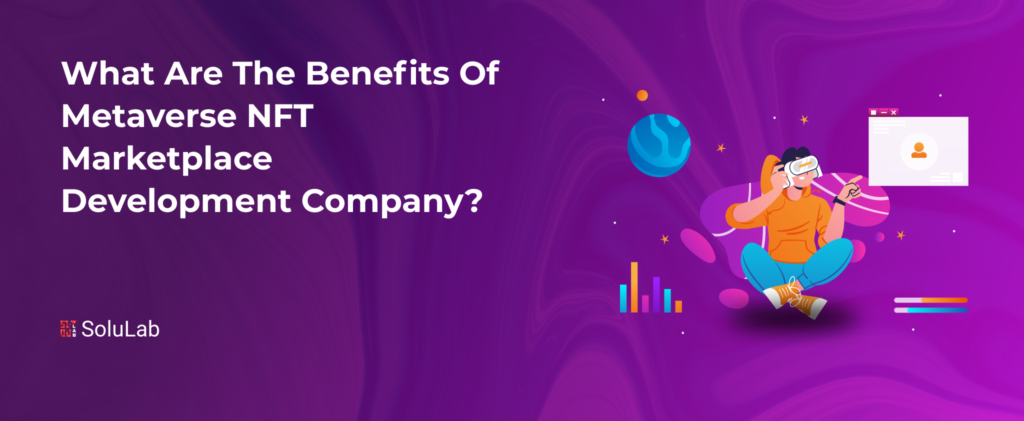
Metaverse NFT Marketplace markets have grown in prominence, and they are changing how we see and interact with digital goods. These metaverse markets provide a venue for users to purchase, sell, and trade unique digital assets known as Non-Fungible Tokens (NFTs). Let’s examine these markets’ multiple advantages to authors, collectors, and the larger metaverse community.
-
Authenticity and Ownership
NFT uses blockchain technology to ensure digital asset authenticity and ownership in the Metaverse NFT Avatar market. Each NFT symbolizes a one-of-a-kind digital object or piece of artwork, and its request is recorded on the blockchain, assuring transparency and removing the potential of counterfeit or replicated assets.
This ensures artists and collectors that their digital assets are authentic and verifiable.
-
Opportunity for Monetization
NFT in metaverse development companies provides authors an unparalleled opportunity to monetize their digital works. Artists, musicians, and content providers can create NFTs of their work and sell them on various channels.
This allows them to engage their audience directly, create market value for their products, and earn royalties from future sales.
-
Worldwide Reach and Accessibility
The worldwide reach and accessibility of NFT in metaverse development are one of their most notable features. These platforms cross borders, allowing artists to display their work globally. Collectors and purchasers, meanwhile, may access and acquire digital assets from anywhere in the globe.
This worldwide marketplace promotes cultural exchange, cooperation, and new opportunities for artists and collectors.
-
Transparency and traceability
Transparency is a key feature of Metaverse NFT Marketplace development. All transactions, ownership transfers, and interactions with NFTs are recorded on the distributed ledger and are available to all participants thanks to blockchain technology.
This openness eliminates the need for intermediaries while lowering the possibility of fraud or manipulation. Collectors can verify the ownership history and provenance of NFTs, increasing market trust and confidence.
Read Our Blog: Top 10 NFT Marketplace Development Companies
-
Increased Creativity
Metaverse NFT Marketplace development company provides innovators greater creative flexibility. Unlike conventional art marketplaces, these platforms do not have gatekeepers or intermediaries, allowing creators to engage directly with their audience while maintaining ownership over their work.
Artists may try new mediums, investigate emerging digital art forms, and interact with a wide spectrum of collectors and enthusiasts. This independence promotes artistic inquiry and invention.
-
Community Engagement and Collaboration
NFT in metaverse development companies generate lively producers, collectors, and fan communities. These platforms enable people with similar interests to connect, cooperate, and communicate with one another.
Users may join discussions, attend virtual events, and keep track of their favorite artists or collections. These markets foster a healthy ecology in which ideas are shared, partnerships are developed, and relationships are forged.
-
Interoperability and Cross-Platform Integration
Metaverse NFT Marketplace development value interoperability, allowing users to move and use their digital assets across virtual worlds and platforms. An NFT acquired in one metaverse can be displayed, exchanged, or used in another.
This seamless connection increases the usefulness and worth of digital assets by giving users a larger canvas to express themselves and participate in various metaverse activities.
-
Preservation of Digital Art and Culture
The creation and trading of digital assets in Metaverse NFT Marketplace development company contribute to conserving digital art and culture. These markets keep a permanent and decentralized record of digital works, ensuring their long-term viability and accessibility for future generations.
These platforms identify and verify the cultural relevance of digital inventions by providing a market for digital art and collectibles, preventing them from being lost or forgotten.
What are the Technological Attributes Present in Metaverse Marketplace Development?
The creation of the Metaverse development relies on various cutting-edge technologies to construct immersive and dynamic virtual worlds in which users may buy, sell, and exchange digital goods.
These technological characteristics are critical in facilitating smooth transactions, assuring security, and improving overall user experience. In this essay, we will look at some of the important technological components involved in establishing metaverse marketplaces.
1. Blockchain Technology
The cornerstone of metaverse markets is blockchain technology. It offers a decentralized and transparent ledger that records all Non-Fungible Token (NFT) transactions and ownership data.
Metaverse markets use blockchain to provide the legitimacy, provenance, and immutability of digital goods by employing blockchain. It facilitates safe peer-to-peer transactions, reduces the need for intermediaries, and builds market confidence.
2. Smart contracts
They are self-executing digital agreements that automate asset exchange depending on established criteria. Smart contracts are essential in metaverse markets for enabling transactions and enforcing selling agreements.
When an NFT is acquired, they automate the transfer of ownership, disburse royalties to artists, and facilitate smooth secondary market trade. Smart contracts provide transaction execution transparency, efficiency, and correctness.
3. Interoperability Protocols
Interoperability protocols allow for the smooth integration and interoperability of various virtual worlds and platforms inside the metaverse. These protocols ensure that NFTs may be moved, shown, and used in multiple metaverse contexts.
They allow users to display their digital assets in different virtual environments, broadening the scope and utility of NFTs. Protocols for interoperability improve the overall user experience and boost the value of digital assets.
4. Decentralised Storage
Metaverse markets require strong and secure digital asset storage solutions. Decentralized storage solutions, which frequently include distributed ledger technology, ensure that NFTs are kept securely and reliably.
Data is distributed among numerous nodes in these systems, lowering the risk of data loss or manipulation. Decentralized storage ensures the safety of digital assets in the metaverse by providing scalability, redundancy, and anonymity.
5. Virtual Reality (VR) and Augmented Reality (AR) technology
Virtual Reality (VR) and Augmented Reality (AR) technologies are important in generating immersive and interactive experiences in metaverse markets. VR immerses viewers in a completely immersive virtual experience, whereas AR superimposes digital features on the actual world.
Metaverse markets improve the visualization and presentation of NFTs by combining VR and AR, allowing consumers to tour virtual galleries, engage with digital art, and try on virtual apparel.
6. Artificial Intelligence (AI) and Machine Learning (ML)
AI and ML technologies are rapidly used in metaverse markets to improve search engines, recommendation systems, and fraud detection methods.
To deliver tailored suggestions and improve the overall user experience, AI systems may assess user preferences, behavior patterns, and transaction history. ML algorithms may also aid in detecting fraudulent activity and the security of transactions.
7. Cryptocurrencies and Wallet Integration
Metaverse markets frequently make transactions using cryptocurrencies such as Ethereum (ETH). For purchasing and selling NFTs, cryptocurrency provides a safe and efficient medium of exchange.
Users may safely store, manage, and exchange digital assets by integrating cryptocurrency wallets into metaverse markets. Wallet integration allows smooth and simple transactions while protecting consumers’ funds.
8. Scalability and Performance Optimization:
Scalability and performance improvement are becoming increasingly important as metaverse markets draw more users and transactions. Technologies like sharding, layer-2 solutions, and off-chain scaling assist in minimizing blockchain congestion, enhancing transaction speed, and reducing costs.
These scaling solutions ensure that metaverse markets can accommodate rising user demand while providing a fluid and responsive user experience.
Read Also: Top 10 Metaverse Development Companies
What is Metaverse NFT?
In recent years, the metaverse concept has gained significant attention and sparked the imagination of individuals and businesses worldwide. At the heart of this virtual realm lies the concept of Non-Fungible Tokens (NFTs). NFTs are unique digital assets that are stored on a blockchain, typically utilizing Ethereum’s ERC-721 or ERC-1155 standards.
Unlike cryptocurrencies such as Bitcoin or Ethereum, which are fungible and can be exchanged on a one-to-one basis, NFTs are indivisible and possess distinct properties that make them one-of-a-kind. Each NFT represents ownership and authenticity of a specific digital asset, whether it’s a piece of artwork, a collectible item, virtual real estate, or even a virtual identity.
NFTs provide a mechanism for proving the ownership and provenance of digital assets in the metaverse. By leveraging blockchain technology, NFTs offer a transparent and secure way to establish virtual goods’ uniqueness, scarcity, and value of virtual goods. The metaverse is a virtual world where these NFTs can be bought, sold, and traded, creating an ecosystem that fosters creativity, ownership, and immersive experiences.
How to Buy Metaverse NFTs
Buying metaverse NFTs can be an exciting and rewarding experience. Here’s a step-by-step guide on purchasing these unique digital assets:
Step 1: Choose a Metaverse NFT Marketplace
Start by identifying a metaverse NFT marketplace that aligns with your interests and preferences. Some popular metaverse NFT marketplaces include OpenSea, Rarible, SuperRare, and Decentraland Marketplace. Each platform has its own unique features, collections, and user base, so take the time to explore and find the marketplace that suits your needs.
Step 2: Create a Digital Wallet
To buy and store NFTs, you’ll need a digital wallet that supports the blockchain on which the NFTs are based. The most common wallet for Ethereum-based NFTs is MetaMask, which is available as a browser extension or a mobile app. Install and set up your wallet, following the instructions provided by the wallet provider.
Step 3: Fund Your Wallet
Once your wallet is set up, you must add funds. Depending on the wallet you’re using, you may be able to purchase cryptocurrencies like Ethereum directly within the wallet or transfer them from another exchange. Ensure that your wallet has sufficient funds to cover the cost of the NFTs you wish to purchase, as well as any associated transaction fees.
Step 4: Browse and Discover NFTs
Explore the marketplace’s collections and discover the NFTs that catch your interest. Metaverse NFT marketplaces typically categorize NFTs by type, artist, popularity, and more, making it easier for you to find what you’re looking for. Take your time to browse through the available options and explore the diverse range of digital assets.
Step 5: Place Your Bid or Make a Purchase
Once you’ve found an NFT you’d like to buy, you have a couple of options. If the NFT is listed at a fixed price, you can simply click on the “Buy” button and follow the prompts to complete the transaction. If the NFT is listed for auction or as a “bid only” item, you can place your bid or make an offer based on the instructions provided by the marketplace. Remember that there may be a time limit for auctions, and you’ll need to stay engaged to ensure you don’t miss out.
Read Our Blog Post: Benefits Of An NFT Marketplace On Cardano
Step 6: Confirm the Transaction
After you’ve selected the NFT and agreed on the price, the marketplace will prompt you to confirm the transaction. Review the transaction details, including the NFT’s description, price, and any associated fees. Ensure that all the information is accurate, and if you’re satisfied, proceed with confirming the transaction.
Step 7: Pay for the NFT
To complete the purchase, you’ll need to pay for the NFT using the marketplace-supported cryptocurrency. Typically, this involves transferring the required amount of Ethereum or another compatible cryptocurrency from your digital wallet to the designated wallet address provided by the marketplace. Follow the instructions provided by the marketplace and your wallet to initiate and confirm the transaction.
Step 8: Wait for Confirmation
Once you’ve submitted the transaction, it will be added to the blockchain network for verification and confirmation. The time it takes to confirm the transaction can vary depending on network congestion and other factors. Be patient and wait for the confirmation, which will be visible in your wallet’s transaction history.
Step 9: Transfer the NFT to Your Wallet
Once the transaction is confirmed, the NFT will be transferred to your digital wallet. The wallet will provide you with the necessary information to view and manage your NFT, including its unique identifier, metadata, and associated rights. You can store, display, or transfer the NFT as desired, depending on the capabilities of your wallet and the specific NFT.
Step 10: Enjoy and Engage with Your Metaverse NFT
Congratulations! You’re now the proud owner of a metaverse NFT. Take the time to appreciate and enjoy your digital asset. Depending on the metaverse and the capabilities of the NFT, you can showcase it in virtual galleries, use it within virtual worlds and games, or engage with other collectors and creators in the metaverse community.
What are the Fundamental Tools and Technologies Needed for Market Development?
A robust foundation of tools and technologies that enable rapid development, flawless functionality, and a wonderful user experience is required to build a successful marketplace. This post will look at some of the most important tools and technologies for marketplace development.
1. Programming Languages
Programming languages are fundamental to market development. Different wording might be utilized depending on the needs and preferences of the development team. Popular options include:
- JavaScript is a flexible programming language used for both front-end and back-end development.
- Python is extensively used for web development because of its simplicity and readability.
- Ruby is well-known for its clean syntax and simplicity of use, and it is frequently used with the Ruby on Rails framework.
- PHP is a popular web development language with frameworks like Laravel.
2. Frameworks
Frameworks give an organized approach to development, with pre-built components and libraries that help to speed up the process. Frameworks for marketplace development that are often utilized include
- Ruby on Rails: A full-stack framework noted for its efficiency and simplicity of use that stresses convention over configuration.
- Django: A high-level Python web framework that encourages rapid development while adhering to the “don’t repeat yourself” (DRY) philosophy.
- Laravel: A PHP framework with clear and elegant syntax and many built-in capabilities.
3. Database Management Systems (DBMS)
A DBMS is required to store and manage data in a marketplace. Popular market development options include
- MySQL: A popular open-source relational database management system noted for scalability and performance.
- PostgreSQL: A powerful and feature-rich open-source database management system (DBMS) noted for its robustness and support for complex data formats.
- MongoDB: A versatile and scalable NoSQL database that makes it simple to work with unstructured data.
Read Also: How is NFT Music Transforming The Music Industry?
4. Front-End Development Tools
Marketplace development must create an appealing, user-friendly front-end interface. Front-end development tools that are regularly used include
- HTML/CSS: The building blocks of web development used to structure and style web pages.
- Frameworks and Libraries for JavaScript: React.js, AngularJS, and Vue.js are popular solutions for creating interactive and responsive user interfaces.
- Cloud Services and Hosting: Cloud services and hosting platforms guarantee that marketplace apps are scalable, reliable, and accessible. Among the prominent alternatives are:
- AWS (Amazon Web Services): A complete cloud computing platform that provides various services such as hosting, storage, and database administration.
- Microsoft Azure: It is a versatile and scalable cloud platform that offers a variety of hosting, storage, and analytics services.
- GCP (Google Cloud Platform): A cloud computing service package that provides scalable infrastructure and several application development and deployment tools.
5. Analytics and Monitoring Tools
Monitoring and analyzing market performance is critical to detect and manage difficulties. Among the most often used analytics and monitoring tools are:
- Google Analytics: Gives you precise information on user behavior, traffic sources, and conversion rates.
- New Relic: Tracks application performance, finds bottlenecks and delivers real-time performance measurements.
What is the Cost of Developing the Metaverse Marketplace?
Several variables impact the overall cost of developing a metaverse marketplace. The project’s complexity, intended features, development methodology, technology stack, and team size are all important factors. While providing an accurate cost estimate with detailed project information is easier, we may investigate the aspects contributing to the total cost of establishing a metaverse marketplace.
-
Project Scope and Complexity
The extent and complexity of the metaverse marketplace substantially influence the development cost. The number of features, customization needs, and interaction with external systems increases the complexity. A marketplace with simple functionality will be less expensive than a platform with advanced features such as virtual reality (VR), augmented reality (AR), or blockchain integration.
-
Design and User Experience
A visually appealing and user-friendly design is essential for a metaverse marketplace. The cost is influenced by the intricacy of the invention, the number of displays, and the interactive aspects. Customized UI/UX design and immersive VR/AR experiences require additional development work and expenditure.
-
Technology Stack
The technology stack chosen has an impact on development costs. The development difficulties and expenses of various programming languages, frameworks, and libraries differ. Choosing well-established technologies may result in faster growth, but embracing newer or niche technologies may require more effort and knowledge, raising the cost.
-
Blockchain Integration
Integrating blockchain technology into a metaverse marketplace, particularly for NFT (non-fungible token) transactions, increases the development process’s complexity and expense. Blockchain deployment entails smart contracts, transaction verification, and safe storage, necessitating blockchain development knowledge and may require additional resources.
-
Third-Party Integrations
Third-party integrations, like payment gateways, analytics tools, and social networking platforms, can improve a metaverse marketplace’s functionality and user experience. However, each integration complicates the development process, necessitating more time and effort. The complexity of the APIs, documentation, and requirements determines the cost of these integrations.
Conclusion
Metaverse NFT Marketplace developments alter our perceptions of and interactions with digital assets. As the metaverse expands, these marketplaces provide intriguing options for artists, collectors, and entrepreneurs. You may build a thriving platform that enables the trade of unique digital assets inside this virtual reality by grasping the basic ideas and following best practices in Metaverse NFT Marketplace development. Accept this new frontier and let your imagination run wild in the metaverse!
Metaverse NFT marketplace development companies offer several advantages to producers, collectors, and the larger metaverse community. These markets have transformed how we view and interact with digital goods, from proving legitimacy and ownership to unleashing new revenue options. Metaverse NFT Marketplace markets are creating the future of the digital economy and the metaverse ecosystem by focusing on openness, accessibility, and creative freedom.
Check Out our Blog: Things you need to know about NFT Marketplace
The construction of a metaverse marketplace involves various technological features to build immersive, safe, and efficient virtual environments for buying, selling, and exchanging digital goods. The metaverse marketplace ecosystem is powered by blockchain technology, smart contracts, interoperability protocols, decentralized storage, VR/AR, AI/ML, cryptocurrency integration, and scalability solutions, to name a few major components.
SoluLab, a leading provider of Metaverse development services, specializes in turning dream projects into reality. With a team of proficient Metaverse experts, they offer customized solutions tailored to meet the varied needs of clients. By leveraging top-notch tools and cutting-edge technologies, SoluLab ensures premium quality in its NFT marketplace development services. From artwork and digital collectibles to gaming and asset tokenization, they possess proven experience across a wide range of NFT solutions. Their marketplace development services are known for their feature-rich nature and commitment to perfectionism. To bring your Metaverse NFT marketplace vision to life, contact SoluLab today.
FAQs
1. What exactly is the Metaverse NFT marketplace?
A metaverse NFT marketplace is a virtual world or metaverse-based online platform where users may buy, sell, and trade non-fungible tokens (NFTs). It offers a digital marketplace for artists and collectors to engage, exchange, and monetize their one-of-a-kind digital assets.
2. What is the operation of a Metaverse NFT marketplace?
A Metaverse NFT marketplace uses blockchain technology to secure digital asset ownership, validity, and scarcity. Users may sell their NFTs, and others can browse, search, and buy those assets with cryptocurrency. Smart contracts enable safe transactions and the automated distribution of royalties to authors.
3. What are the advantages of creating a Metaverse NFT marketplace?
Creating a metaverse NFT marketplace has various advantages, including
- Artists, musicians, game developers, and content creators may monetize their digital assets and receive royalties on subsequent sales.
- User engagement increases because users may explore and interact with unique digital goods, boosting their immersion and experience in the metaverse.
4. What technologies are used to create the Metaverse NFT marketplace?
The development of the Metaverse NFT marketplace incorporates several technologies, including
- NFTs, which are often developed on blockchain platforms like Ethereum, Binance Smart Chain, or Flow, offer the infrastructure required for asset ownership and transactions.
- These self-executing contracts allow for the automated transfer of ownership, payment of royalties, and other preset activities without mediators.




